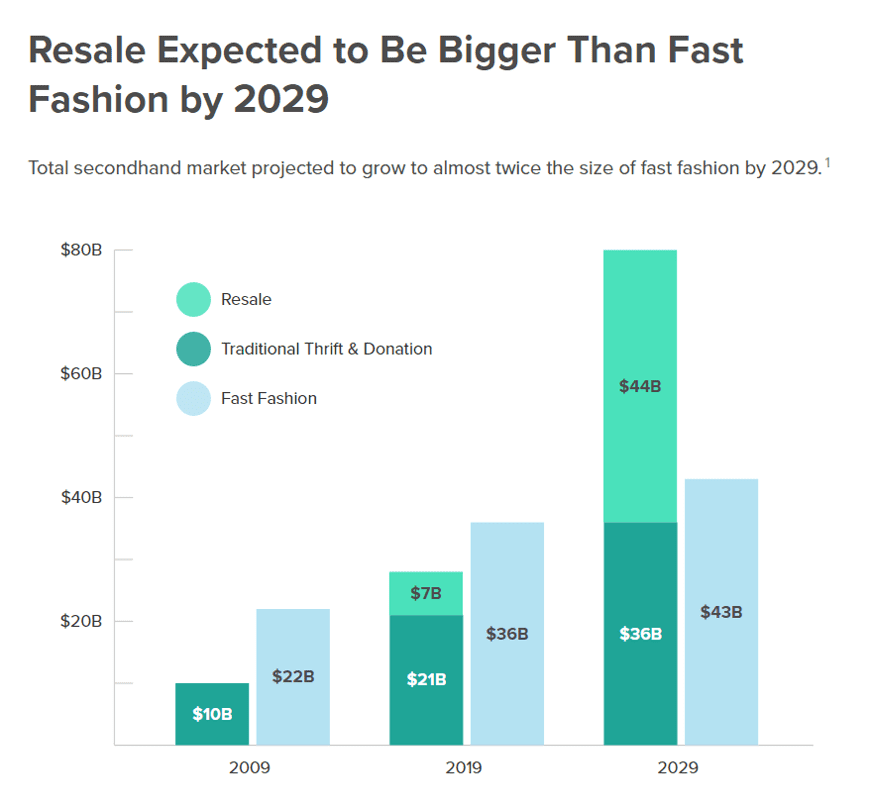During the pandemic, second-hand fashion has been the focus of the fashion industry. A report published by ThredUp has shown that by 2029 the second-hand fashion market will have grown a worth of over 80 billion dollars, which is set to be almost twice the size of the worth of the fast fashion market. With lockdown giving consumers an unlimited amount of time to deep clean their wardrobes, the realisation of just how much they buy and don’t wear has catapulted fashion resale into the spotlight.

Image Credit: https://www.thredup.com/resale/#resale-growth
In the UK alone, an astounding 336,000 tonnes of clothing are sent to landfill each year. Love Your Clothes, a campaign launched in 2014 to encourage change in how UK consumers ‘buy, use and dispose of their clothing’, found that if we can extend the average life of our clothes to approximately three years, ‘we could reduce their carbon, water and waste footprints’. By investing time into extending the lifespan of clothes, the outcome will not only benefit the fashion industry but the environment.
“The production of clothing is incredibly resource intensive,” said sustainable fashion blogger, Charlotte (@sustainablychar). “Re-wearing a garment and extending its lifespan by a mere nine months can help to reduce its environmental impact by up to 30%, so buying second-hand is an incredibly easy way to do this.”
Fashion resale apps, stores and websites have seen an unprecedented growth throughout 2020. Lockdown has brought nothing but time to research into the effects of fast fashion and prove the need for keeping our garments in a cycle, rather than sending them to landfill. It is evident that trends come back around year after year, so recycling and archiving them for the next generation is a business model that is key to success in second-hand. The Telegraph recently announced that second-hand fashion marketplace, Depop, was set to expand their UK team by almost a quarter, to over 320 staff members. This follows the double in demand for second-hand fashion on their app during lockdown.
“The resale sector will eventually make up a huge percentage of the fashion industry,” said Rosie Mckeown, the owner of top selling, vintage and sustainable fashion, Depop store, @theslowstore. “People are showing they are more and more interested in buying and renting pre-loved, so I think business models that don’t factor this in might struggle.”
Fashion resale opens brands up to a larger consumer market, with the discounted prices allowing for a more diversely budgeted audience. The increase in purchases of second-hand clothing is down to a range of factors, one of which could be the tighter budgets of many consumers throughout lockdown, with furlough schemes leaving shoppers with little to no disposable income. Research carried out by GlobalData, a third-party retail analytics firm, found that 4 in 5 Americans said they would be open to shopping second hand when ‘money gets tight’. Discounted clothing, due to second-hand resale companies allows fashion to be a more accessible market to all.
“One of the reasons the interest in fashion resale is growing is simply due to second-hand fashion being much more affordable for the everyday person”, said Cieran Harris, Company Director of Timeless Vintage Co, a luxury handbag and accessory resale company. “It gives an item a second life, which is absolutely fantastic, not to mention how sustainable buying second hand is.”
More luxury brands are expanding their reach to the resale market. Renowned global brands, Gucci and Levi launched their own second-hand initiatives in 2020. Gucci announced a partnership with US resale website, therealreal.com, which houses many other luxury brands, such as Stella McCartney and Burberry, who offer their own resale alternatives. Levi further announced they would be launching their own e-commerce site and second-hand initiative, which will provide the market with more vintage and pre-loved alternatives adding to their already sustainable collection. Clothing has proven not to be the only area of fashion to succeed in second-hand market as Handbag Clinic provides a restoration service on pre-loved luxury handbags along with buying, selling and authenticating.
Charlotte Staerck, Retail Director and Co-Founder of Handbag Clinic stated, “we’ve witnessed a huge acceleration in demand for buying and selling pre-owned and luxury handbags over the last year. We’ve had a record year on year growth with an increase of 500%.”

Image Credit: https://www.handbagclinic.co.uk/
“Over the last 12 months, pre-owned handbags have risen in value by an all-time high of 13%, outperforming all other collectable assets including art (5.2%), fine wine (0.7%) and jewellery (-6.7%)’ said Charlotte Staerck. “Whilst high streets are collapsing, and sales of non-essential items have plummeted during the pandemic, resale and auction sites selling luxury and vintage handbags are thriving because they are considered a safer investment than stocks and shares.”
The consumers accountable for the explosion of secondary fashion are Generation Z. The open mindset of the younger generation and willingness to accept a need for change has proven to power the growth of fashion resale. Over 40% of under 24’s shopped second hand in 2019 and 90% said there is no longer a stigma to purchasing ‘used fashion’ in a survey created by GlobalData.
“New clothes used to be a special treat, not a necessity,” said Charlotte, a sustainable fashion blogger (@sustainablychar). “Second-hand and old clothes were the norm – be they hand-me-downs or mended from years of use, there was no stigma then to make do and mend and so there shouldn’t be any now. More than this, buying second-hand has not only economic but environmental and ethical benefits, so it should be something to be proud of.”
With second-hand fashion once being a possession that was looked down upon, this year has brought a shift in perspective with shoppers now being more open to purchasing from resellers than ever before. ThredUp discovered that 70% of women are now open to shopping second hand in comparison to less than 50% who were asked in 2016. With the stigma slowly starting to fade, more brands are open to the idea that second-hand fashion is the way to revolutionise their sales and reach more consumers.
“There will always be a market for pre-loved,” said Lyndsey Jackson, the owner of second-hand vintage store, Corner 93. “It’s an interesting business to unearth wardrobes that have been dormant for years and it’s all part of telling the story of fashion. It is essential to keep items worn and loved for as long as we can.”
The ever-increasing benefits to having a business model focused on the secondary market are evident in the success and growth in sales for businesses within the resale market in 2020 alone. Sales are only set to expand further with ThredUp research showing the resale market has a compound annual growth rate of 39%. Now is the time to invest in the life cycle of your products and invest in the promotion of second-hand fashion.
